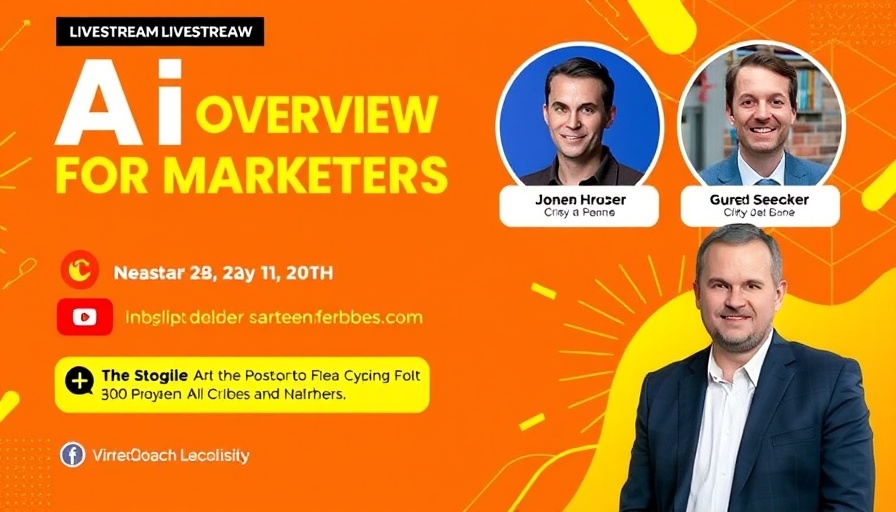
Unlocking the Secrets of Human Behavior in Marketing
In the ever-evolving world of marketing, understanding human behavior can revolutionize your approach. Have you ever felt as though you were pulling your hair out trying to get people to engage with your content? Well, you might just be missing the mark on a few fundamental truths about what drives human decision-making. How can we tap into this knowledge to influence our audience’s choices? In this article inspired by Nancy's enlightening video, How Human Behavior Impacts Your Marketing Strategy, we'll explore some inconvenient truths about human behavior and what they mean for your marketing messages.
In How Human Behavior Impacts Your Marketing Strategy, the discussion dives into fascinating truths about decision-making, exploring key insights that sparked deeper analysis on our end.
The Power of Gut Instincts: Why People Don’t Overthink
Let’s face it: most people make decisions based on gut feelings rather than meticulous analysis. It might sound harsh, but it’s true! Behavioral science shows that we make emotional decisions and then rationalize them later. For instance, do you really think the average person spends hours weighing the pros and cons before picking a movie for the night? Nope! They usually just go with their gut. As marketers, this presents us with a marvelous opportunity to reach our audience emotionally.
Using Emotion to Drive Engagement
Have you ever noticed how some emails grab your attention while others get lost in the abyss of your inbox? Take the example of a lawn care service. Instead of saying, “We provide efficient lawn maintenance,” what if they highlighted how their service would make you the envy of everyone in the neighborhood? This is why effective content should blend emotional appeal with practical reasoning. So, always remember to mix that emotional button with your rational sales points.
Don't Fear Loss: Use It to Your Advantage
Now, let’s chat about something called loss aversion. It turns out people prefer avoiding losses to achieving gains. It's like finding a $20 bill on the street that makes you smile compared to losing a $20 bill that ruins your day! To harness this, use fear of missing out in your marketing. For example, “Sign up now or miss out on our limited-time offer.” By framing your offer in terms of loss, you'll likely see a spike in engagement. Your audience won’t want to be the one missing a deal!
The Endowment Effect: It’s Mine, Therefore It’s Valuable
The endowment effect teaches us that once people own something, they tend to value it more. This can work wonders in your marketing. For example, instead of offering discounts, remind your customers of the value they already possess: “You’ve earned this exclusive offer!” This nudge plays right into people’s natural possessiveness, nudging them toward making a purchase.
Influence the Unconscious: Factors at Play
What’s that? You think you know why you make your decisions? Think again! Oftentimes, external factors shape our choices in ways we aren’t fully aware of. If you can utilize strategies that lean into this unawareness, you can grip your audience's attention even more tightly. Ever noticed how many things we buy just because they are presented as popular? This is a classic example of conformity bias.
Autonomy Bias: The Freedom to Choose
We all want to feel like we are in control, don’t we? Autonomy bias tells us that having choices makes people more likely to engage. Consider presenting options rather than a simple yes or no: “Would you prefer A or B?” This creates a subtle yet powerful impact, making your audience feel involved and significant.
Labeling: Use It Wisely!
Labels can influence behavior significantly. When someone is labeled as part of a specific group, they are more likely to act in accordance with that group’s norms. For instance, marketing can benefit from telling consumers they are “savvy” or “discerning,” encouraging them to make a purchase aligning with that self-image. So, don’t hesitate to employ smart labeling in your campaigns!
Money Matters: Change Your Perspective
And lastly, let’s not forget the peculiar relationship humans have with money. We often think of smaller, immediate rewards as more appealing than larger, delayed ones. This is where you need to shift your language. Highlight how making wise decisions today could lead to financial security tomorrow. This way, you bridge the gap between the present and future selves.
Your Winning Strategy: Integrate These Insights!
So, what have we learned? Understanding these inconvenient truths about human behavior is key to crafting a marketing strategy that resonates. By incorporating emotional appeal, leveraging loss aversion, recognizing the endowment effect, and embracing autonomy in your campaigns, you’ll be better positioned for success. And remember, get creative! Your marketing’s effectiveness largely hinges on understanding the psychology behind your audience's decisions.
Have you explored the world of human behavior in your marketing efforts? If not, consider trying out these tips! Together, we can conquer the world of marketing by tapping into the mind of our consumers! After all, success doesn’t just come from great products—it comes from understanding the people who use them. Whether you’re a start-up or a seasoned business, knowing the psychology of your audience is vital to your success!
Looking for help with your press release distribution or to refine your next digital PR strategy? Don’t hesitate to reach out! Explore our resources and discover how you can unlock the full potential of your marketing!
 Add Row
Add Row  Add
Add 




 Add Row
Add Row  Add
Add 

Write A Comment